We live in a time when the state of our planet is rapidly deteriorating, and green jobs are increasing. The question is how to land on a green job fast enough to impact the environment and help the companies meet their sustainability goals?
These industries are experiencing the most growth in environmentally responsible work: wind energy, solar power installation, geothermal energy, forestry and conservation science, and recycling and waste management which the United Nations estimates that by 2030 the economy will create another 23 million jobs worldwide.
Today, you’ll learn the seven different green jobs with their responsibilities, educational requirements, occupational outlook, and average annual salary, which many of these pay quite well- some over six figures. In fact, you can tap into these jobs by taking courses to ensure that you’re equipped with these high-demand professions.
- Chief Sustainability Officer
- Environmental Engineer
- Environmental Lawyer
- Hydrologist
- Wildlife Biologist
- Conservation Scientist
- Urban and Regional Planner
What are green careers?
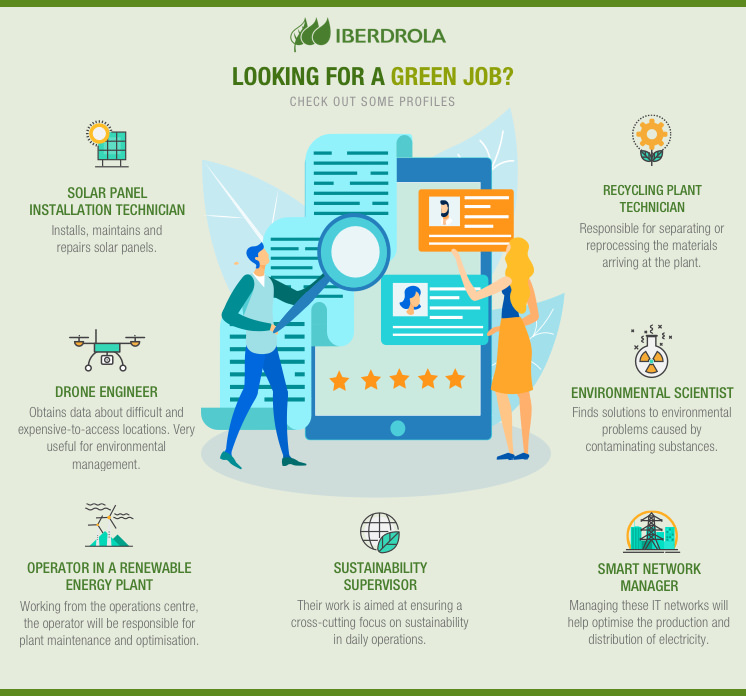
A green career is employment that genuinely contributes to a more sustainable world, such as conserving energy, stopping overfishing, reducing pollution, or recycling. It encompasses all the sectors of the societies like food, energy, education, government, and transportation.
Green jobs help improve energy, limit greenhouse gas emissions, minimize waste and pollution, protect and restore ecosystems, and improve recycling systems.
Without further ado, let’s take a look at some rapidly-growing career paths that are best suited for those of you who want nothing more than to save the planet and make a difference.
1. Chief Sustainability Officer
Imagine without someone to design strategies for resource conservation, and there would be a lot more waste in our world. A new position has evolved since the start of the 2000s as some companies have engaged in more efforts around sustainability and environmental aspects.
The Chief Sustainability Officer is responsible for helping organizations ensure that their business practices are environmentally, economically, and socially sustainable. They will work and collaborate with departmental managers, present proposals and recommendations confidently, facilitate and oversee the company’s performance evaluations to minimize the company’s environmental impact.
“Companies are monitoring the impact they’re having environmentally and on society, and the appointment of the CSO reflects an underlying need for companies to not only monitor but also improve their performance,” says Harvard Business School associate professor George Serafeim.
Average Annual Salary
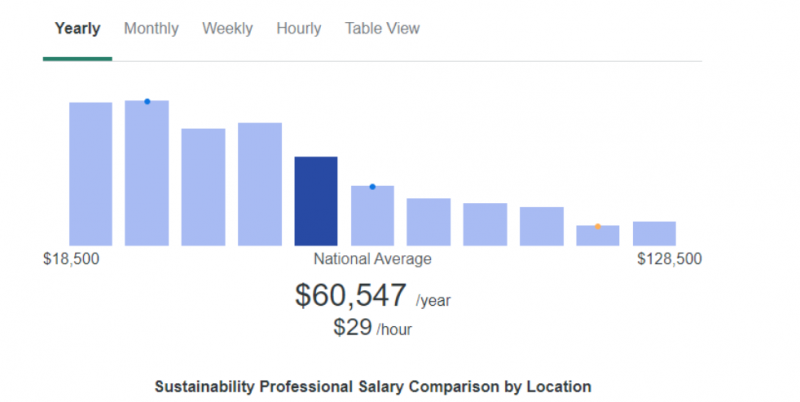
As of March 2021, ZipRecruiter reports that the average annual salary for a sustainability professional in the U.S. is $60,547 or $29/hour. The yearly salary is veering from $50,000 to $280,000, according to the State of the Profession 2020 Report.
According to ZipRecruiter, the majority of Sustainability Professional salaries currently range between $33 000 (25th percentile) to $77,500 (75th percentile), with top earners (90th percentile) making $109,500 annually across the United States.
The average pay range for a Sustainability Professional varies greatly (by as much as $44,500), which suggests there may be many opportunities for advancement and increased pay based on skill level, location, and years of experience.
How to Become a Chief Sustainability Officer

You’re probably asking what major or degree you need to take to become a Chief Sustainability Officer. Here are the survey results gathered by owlguru.com about their degree when they became Chief Sustainability Officers.
According to owlguru, many Chief Sustainability Officers begin their careers by earning a bachelor’s degree in business-related fields or fields supporting their jobs in a specific industry.
Some colleges and universities offer minors in sustainability with resources and study materials that students may earn in addition to their major for those who wish to enter the sustainability field. Students may be required to take courses in sustainability, environmentalism, or other related topics.
Occupational Outlook
Myfuture said the overall employment of top executives is projected to grow 4 percent from 2019 to 2029, and the employment of chief executives is projected to decline 10 percent from 2019 to 2029. Improving office technology and changing organizational structures have increased these workers’ ability to perform tasks previously done by multiple chief executives.
In addition, economic activity and employment have become increasingly concentrated in large, established companies, which may lead to fewer new jobs for these workers.
2. Environmental Engineer

Environmental engineers are highly skilled individuals who specialize in making our planet a healthier place. They are involved in conducting hazardous-waste management studies, controlling water and air pollution in which they evaluate the significance of the hazard and advice on treating and containing it.
Some environmental engineers study ways to minimize automobile emissions, global warming, and ozone layer depletion. They also work and collaborate with other engineers, environmental scientists, and specialists in law to address environmental problems such as air and water pollution.
Average Annual Salary

According to careerexplorer.com, the average salary is $88,860 per year for an environmental engineer in the United States. The wages typically start from $54,330 and go up to $142,070.
How to Become an Environmental Engineer?
Some environmental engineers will need at least a bachelor’s degree (B.S.), usually in environmental engineering, chemical, civil, or general engineering.
The students generally study the basic engineering principles, computer-aided design (CAD), mathematics, sustainability principles, air quality control technologies, and alternative energy technologies.
Occupational Outlook
According to colorado.edu, the projected growth rate by 2024 is 8%, and it is one of the largest within engineering disciplines.
3. Environmental Lawyer

An environmental lawyer works with environmental case law and legislation to represent clients in legal issues such as clean technology, climate change law, and other environmental rights.
Environmental lawyers also work with sustainability, renewable energies, HVAC Companies, and anything from rare animals to human-made buildings to the air we breathe. This is another green job that can offer you both a rewarding career and helps you save the planet.
Environmental lawyers are on the frontlines of protecting and securing our natural environments, along with policymakers and environmental advocates.
Average Annual Salary

As of May 08, 2021, ZipRecruiter reports that the average annual pay for Environmental Lawyer is $74,569 a year or $36/hour in the United States.
According to ZipRecruiter, the majority of environmental lawyer salaries currently range between $44,000 (25th percentile) to $90,500 (75th percentile), with top earners (90th percentile) making $119,500 annually across the United States.
The average pay range for an Environmental Lawyer varies greatly (by as much as $46,500), which suggests there may be many opportunities for advancement and increased pay based on skill level, location, and years of experience.
How to Become an Environmental Lawyer?
An environmental lawyer is required to have a bachelor’s degree to be admitted into law school. There’s no specific program of study required, but the students may consider taking a degree in environmental science, business management, or government.
Here’s the suggested step-by-step process to start a career as an environmental lawyer, according to study.com:
- Earn an Undergraduate Degree
- Take the LSAT
- Graduate from Law School
- Take the Bar Exam
- Find Work
- Consider Earning a Master of Laws
Occupational Outlook
The demand for environmental lawyers is growing about as fast as average, with a 6% growth expected over the next 10 years in which approximately 50,100 environmental lawyer jobs will be added by 2028. And if you invest in the law firm marketing, you’ll always stay on top of your game.
4. Hydrologist

This is one of the many green jobs that help environmental properties and other scientists clean up and preserve the environment and search for groundwater. Hydrologists work closely with scientists, engineers, and public officials to manage and study water supply.
The work of hydrologists applies scientific knowledge to solve water-related problems in society and formulate plans to improve resources. They are also concerned with finding water supplies for cities and irrigated farms, controlling soil erosion and river flooding.
Hydrologist works both in the field and offices. They may have to wade into lakes and streams to collect samples or read and inspect monitoring equipment in the area. In offices, hydrologists spend much of their time using computers to analyze data and model their findings.
Average Annual Salary

According to careerexplorer.com, the average salary is $81,270 per year for a hydrologist in the United States. The wages typically start from $51,220 and go up to $127,400.
How to Become a Hydrologist?
To become a hydrologist, you need at least a four-year bachelor’s degree in hydrology, geoscience, environmental science, or engineering focused on hydrology or water science. To advance your career to a higher position, you will require a master’s degree or doctoral degree.
Some countries require hydrologists to have licenses issued by state licensing boards. To get one, you are required to meet certain educational requirements and pass the examination.
Occupational Outlook
According to the U.S. Bureau of Labor Statistics, the projected growth rate by 2029 is a 5% increase for hydrologists.
5. Wildlife biologist

A wildlife biologist is one of the green jobs primarily responsible for studying and managing wildlife populations, habitats, and behavior of various animal populations in the wild.
They are responsible for knowing how many animals of certain species are within their management area and what causes wildlife populations to change. They may also be involved in management decisions such as modifying the habitat.
Since wildlife biologists observe and study the animal’s behavior, they frequently examine and determine factors such as nutrition, diseases, and habitat relationship in a specific ecosystem.
Average Annual Salary
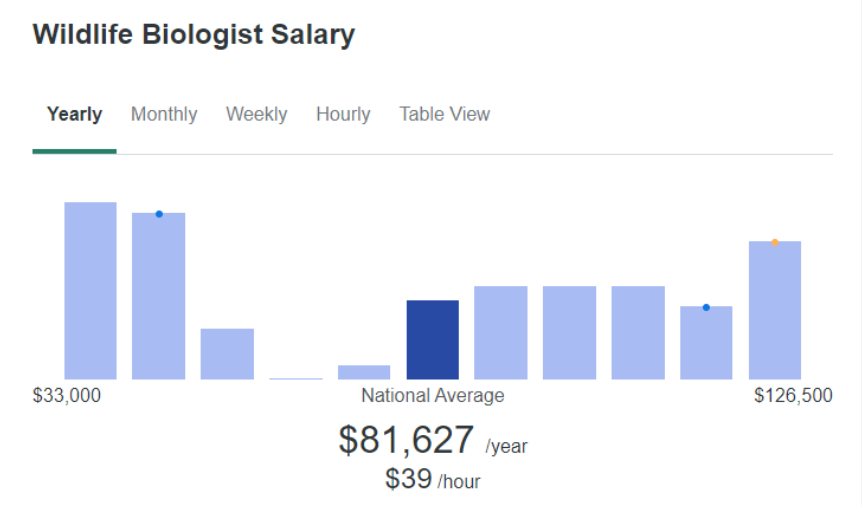
As of May 09, 2021, ZipRecruiter reports that the average annual pay for a biologist is $81 627 a year or $39/hour in the United States.
According to ZipRecruiter, the majority of Wildlife Biologist salaries currently range between $46,000 (25th percentile) to $112,000 (75th percentile), with top earners (90th percentile) making $125,000 annually across the United States.
The average pay range for a Wildlife Biologist varies greatly (by as much as $66,000), which suggests there may be many opportunities for advancement and increased pay based on skill level, location, and years of experience.
How to Become a Wildlife Biologist?
To work in this field, you’ll need to get at least four years of bachelor’s degree, ideally in biology, ecology, and zoology.
Occupational Outlook
According to the U.S. Bureau of Labor Statistics, the demand for wildlife biologists is growing about as fast as average, with a 4% growth expected over the next 10 years.
6. Conservation Scientist
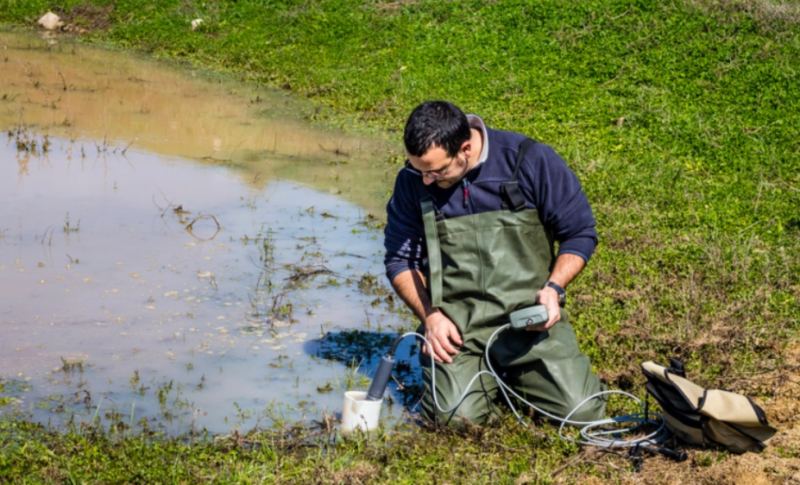
Do you love the outdoors and want to play an essential role in how humans interact with the land around them? You may want to consider a career as a conservation scientist.
A conservation scientist improves, protects, and manages natural resources, parks, rangelands, and the overall land quality of the forest. They will evaluate forest and soil quality environments assessing the damage to trees and forest lands caused by fires and logging activities.
Average Annual Salary

According to careerexplorer.com, the average salary is $62,660 per year for a conversation scientist in the United States. The wages typically start from $39,270 and go up to $98,060.
How to Become a Conservation Scientist?
You need a minimum of a four-year bachelor’s degree in forestry or related fields like natural science, agriculture science, or environmental science.
Occupational Outlook
According to the U.S. Bureau of Labor Statistics, the demand for conservation scientists is growing about as fast as average, with a 5% growth expected over the next 10 years with an employment change of 1,700 from 2019-2029.
7. Urban and Regional Planner

If saving and protecting the planet requires thorough planning and execution, then the role of urban and regional planners is vital in planning land use programs and building up physical facilities to help create and expand communities.
This is one of the green jobs that play an essential role, most especially in towns and cities experiencing high population growth. They promote, design, and administer government plans affecting public utilities, housing, and transportation to prevent pedestrian accidents and contribute to the overall master plan of the town.
Average Annual Salary
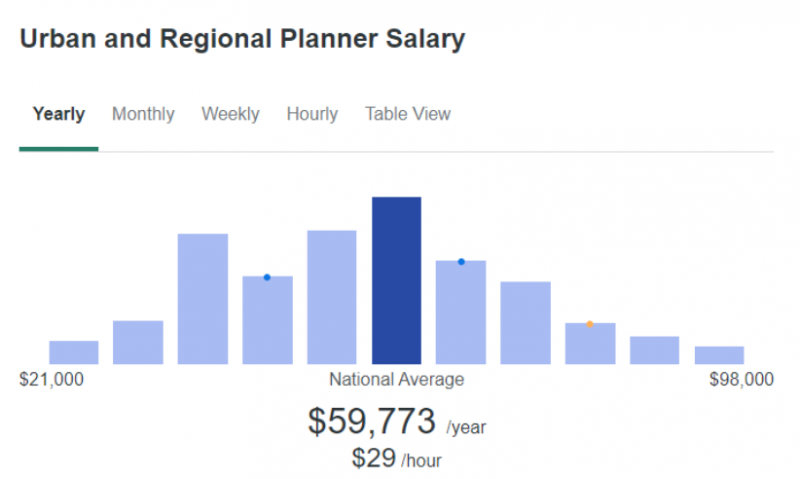
As of May 09, 2021, ZipRecruiter reports that the average annual pay for urban and regional planners is $59,773 a year or $29/hour in the United States.
According to ZipRecruiter, the majority of Urban and Regional Planner salaries currently range between $44,000 (25th percentile) to $68,500 (75th percentile), with top earners (90th percentile) making $83,500 annually across the United States.
The average pay range for an Urban and Regional Planner varies greatly (by as much as $24,500), which suggests there may be many opportunities for advancement and increased pay based on skill level, location, and years of experience.
How to Become an Urban and Regional Planner?
To work in this field, you need a master’s degree from an accredited urban or regional planning program. You may also consider other degrees that emphasize related fields like economics, architecture, geography, environmental management, and sociology.
Occupational Outlook
The demand for urban and regional planners is growing about as fast as average, with 11 percent from 2019 to 2029. Environmental, demographic, and transportation changes will drive employment growth for planners.
Pro-Tip: If you’re more of an entrepreneurial type of person, you can also start a company yourself that specializes in sustainability.
Often you don’t even have to reinvent the wheel. For example, you could build an eCommerce brand that exclusively offers sustainable products – some of my favorite examples are Patagonia, 3Wishes, and Pact. There is an extremely high demand for that and you can combine both – making the world a better place and earning money at the same time.
Wrapping Up
Throughout history, there has been a significant move towards a greener future because of environmental pollution. Many problems face the world today, but the good news is we are stepping up and making a difference in protecting our planet, which benefits both the global economy and the environment.
With increasing awareness and responsibility towards our planet, existing businesses adapt and innovate more environmentally friendly processes. A green economy will lead us to sustainability while improving human well-being and reducing environmental risks.
If you are interested and passionate about the environment, then ‘green jobs’ might be the right choice for you. In fact, you’re in luck because some sectors like environmental science, energy, and biology are growing rapidly and creating greater demand for people who want to make a difference like you.
About the Author
 Burkhard Berger is the founder of awesomex™. You can follow him on his journey from 0 to 100,000 monthly visitors on www.awesomex.com. His articles include some of the best growth hacking strategies and digital scaling tactics that he has learned from his own successes and failures.
Burkhard Berger is the founder of awesomex™. You can follow him on his journey from 0 to 100,000 monthly visitors on www.awesomex.com. His articles include some of the best growth hacking strategies and digital scaling tactics that he has learned from his own successes and failures.




































